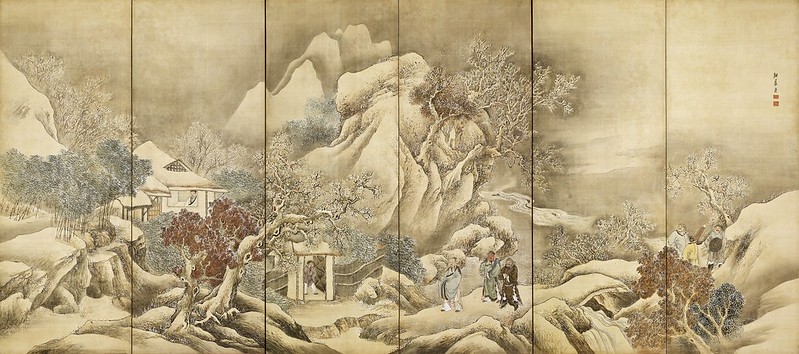Obra de Yosa Buson (1716-1784), pintor japonès (1)
- Recordatori de Barthélemy de Caix -
En el dia de la celebració del seu 300è aniversari de naixement
Parlem de Pintura...
Yosa Buson [与謝蕪村] (Kema, 1716 - Osaka, 17 de gener de 1784) va ser un pintor japonès, especialitzat en Haiku i en pintura Nanga. Al 20 anys es va traslladar a Edo, on es va dedicar a l'estudi de la poesia japonesa sota la tutela del mestre Hayano Haijin. A la mort d'aquest, va marxar a viure a la província de Shimosa. Seguint l'estela deixada per Matsuo Bashō, va decidir viatjar per les zones salvatges del nord d'Honshū, on es localitzen els paisatges que van inspirar el famós diari de viatge de Basho Oku no Hosomichi (L'Estret Camí cap al Interior). Allà va ser on va realitzar les seves primeres publicacions per a les que el poeta va utilitzar el nom de Buson. Als 42 anys va viatjar a la ciutat de Kyoto on hi va viure durant un temps. En aquesta època va començar a utilitzar el nom de Yosa, que va adoptar del lloc de naixement de la seva mare. Allà es va casar amb 45 anys i va tenir una filla, Kuno. A Kyoto es va dedicar a escriure poesia i a donar classes de lírica japonesa. Els darrers anys va tornar a Osaka, on va morir el gener de 1784.
Font: En català: Yosa Buson (1716-1784) - En castellano: Yosa Buson (1716-1784) - In english: Yosa Buson (1716-1784) - Altres: Yosa Buson (1716-1784)
Parlem de Música...
Barthélemy de Caix (Lyon, 20 d'abril de 1716 - c.1790) va ser un intèrpret de viola i un compositor francès. Fill de François-Joseph de Caix (c.1680-1751), i membre d'una respectada família de músics, es va formar inicialment amb el seu pare abans de viatjar a París el 1730. El 1738 va viatjar a Lió no obstant el 1746 va tornar novament a París on va ser intèrpret en un concert celebrat el 16 de setembre d'aquell mateix any. El seu talent va motivar una petició des de Versalles per tal de ser professor de pardessus de viole de la princesa Sofia. Com a compositor va publicar VI sonates pour deux pardessus de violes Op. 1 (París, c.1745). Entre els anys 1775 i 1789 es té constància que va ser professor de pardessus de viole i violoncel. El 1775 va aparèixer documentat com a violoncel·lista del Concert Spirituel si bé es creu que la referència era en nom de Timoléon Louis d’Hervelois de Caix (c.1715-1792). Barthélemy de Caix va morir en una data i ciutat desconegudes.
Font: En català: No disponible - En castellano: No disponible - In english: Barthélemy de Caix (1716-c.1790) - Altres: No disponible
Parlem en veu pròpia o en veu d'altri...
First, de Caix’s sonatas are uncharacteristically demanding for the pardessus. The fivestring pardessus’s main function was to borrow from the vast repertoire of baroque chamber sonatas and suites for bass viol, violin, recorder, flute and oboe for private music-making by women amateurs. Although public performers on the pardessus were reputed to perform concerti, the vast majority of the more than two hundred published works that mention the pardessus on their title page, and the fifty or so works written specifically for the instrument, fall into two basic genres: “galant” solo suites and sonatas with basso continuo, and pastoral treble duets intended to be played in combination with rustic instruments like the recorder, musette, and vielle à roue. While some works contain difficult passages, none are remotely as challenging as the de Caix, either technically or musically. Twenty-first century pardessus players categorize these sonatas as some of the hardest viol music ever written, on a par with Forqueray, Graun and Kühnel. Next, de Caix seems to have employed every bit of idiomatic violin technique he could – bariolage, double and triple stops, high position work, complicated bowings and extended slurs, as well as using such extreme keys as A major and C minor. Indeed, there is a strong stylistic similarity between his treble duos and the violin duos of Jean-Marie Leclair, a longtime family friend.
Tina Chancey (source/font: aquí)
Gaudiu i compartiu!
Informació addicional...
AMAZON: DE CAIX, B. - Six sonatas
IMSLP: No disponible
CPDL: No disponible


Un administrador del blog ha eliminat aquest comentari.
ResponEliminaMuchas gracias
ResponElimina